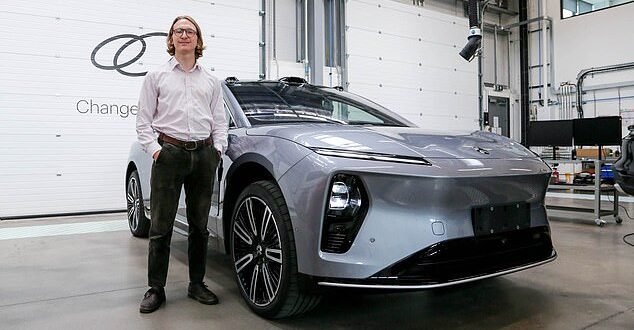The Future of Driving: ClearMotion’s Suspension System
If you suffer from motion sickness, then you know just how quickly a trip down Britain’s winding back roads can turn into a nausea-inducing nightmare. However, there may soon be a solution to this problem. ClearMotion, a Boston-based startup, claims that its latest generation of cutting-edge suspension can ‘eliminate motion sickness’ for good. To test this claim, MailOnline’s reporter, William Hunter, took a trip to their Warwickshire testing facility.
How the Technology Works
Installed in the luxury NIO ET9, ClearMotion’s suspension acts like a pair of noise-cancelling headphones for the road. With compact motors tucked away above each wheel and a sophisticated onboard computer, the system can push and pull the wheels to cancel out bumps in the road. In theory, this should mean all the swaying and shaking that normally triggers a bout of motion sickness should be removed.
Unlike the suspension in almost every other car, the ClearMotion suspension system is ‘active’. Normal gas and spring-based systems are passive, which means they simply place a buffer between the wheels and the body of the car to dampen the motion. But, no matter how good a passive system might be, it can never completely negate that motion because the spring can’t compress and expand fast enough. Active solutions get around this problem by adding outside power to the suspension system.
The ‘Sky Hook’ Approach
With ClearMotion, when the wheels start to feel an obstacle, such as a speed bump, the compact motors rapidly pull the wheels up so that this movement isn’t transferred up to the passengers. This is what ClearMotion CEO Christian Steinmann calls the ‘sky hook’ approach; the body stays perfectly level while the wheels pump up and down to follow the contours of the road. Drivers can even tailor their performance on the go, dialing in a stiffer sporty feel or cancelling out as much motion as possible.
Real-World Experience
Over the course of the afternoon, we put the NIO ET9 equipped with ClearMotion’s suspension to the test on everything from winding back roads to a specially designed vehicle test track. After spending the morning learning about the tech, I was excited to feel just how velvety smooth the ride could be. But as we raced along a B road, I was almost a little disappointed. The ride was certainly exceptionally smooth, but there were still a few rumbles and shakes rather than the maglev-like experience I’d been expecting.
Then our host suggested turning the active system off for a moment so I could really feel the difference. Suddenly, we were bumping and lurching and rolling around like a ship on a stormy sea. Lumps and divots I had been blissfully ignorant of suddenly seemed to appear out of nowhere. Where I had been making notes on my experience, I could now hardly touch pen to page before being jolted into an illegible scribble. Now I realized just how bad this pothole-ridden track really was, and just how good ClearMotion’s system had been.
Limitations and Improvements
Of course, even the best active system can’t create the perfect ride if it’s just being reactive. Marco Giovanardi, ClearMotion Technical Fellow, told MailOnline: ‘It is like a blind man feeling his way down the road. You can be quick to respond, but you’re always responding in the moment.’ This becomes a problem when the road contains obstacles which are bigger than what the suspension system can absorb.
RoadMotion Software
To address this, ClearMotion is preparing to release a piece of software called RoadMotion. RoadMotion collects GPS data and combines this with information coming from the suspension to create a map of the road which captures every bump and imperfection. When you start to drive down that road again, your car feels the motion of the road to work out your location. Mr. Giovanardi says that this is like Shazam for the road, but instead of recognizing patterns in music, it recognizes patterns in potholes.
Once a road is fully mapped, RoadMotion is so accurate that it can calculate the car’s position within an accuracy of one centimetre, even driving through tunnels without GPS. With that map of the road ahead, the car’s suspension system uses AI to plan out its movements so that any motion is reduced to an absolute minimum.
Does It Prevent Motion Sickness?
But the big question is not whether ClearMotion feels nice to drive, but rather whether it actually solves motion sickness. Throughout the day, I did everything I could to make myself as nauseous as possible. I sat in the back seat, wrote emails on my phone, read a book, and even closed my eyes as I was driven around and around windy roads. Surprisingly, while that would normally have me reaching for the sick bags, I barely felt anything more than the slightest discomfort.
Despite how much better it was than any car I’ve ever been in, there was still room for improvement, and CEO Christian Steinmann agrees. ‘At the moment we are still in reactive mode,’ Mr. Steinmann told MailOnline. ‘You still have a human in the driver’s seat, and we can only react to the demands of the driver.’ His ultimate vision is that ClearMotion suspension would be used in autonomous vehicles, allowing humans to work or rest in peace while the car makes the ride as smooth as possible.
 Info Malang Raya Its All About World News
Info Malang Raya Its All About World News



